ABOVE: Dr. Huey Paul Beckham, Jr., Dr. Keisha Burnett, and Dr. Aziza Glass pose inside the lobby of the CAWLM Veterinary Hospital (Photo by J. Raphael’s Photography)
Three Prairie View A&M University alumni have come together to provide animal care for the Third Ward community. CAWLM (4902 San Jacinto St) offers a wide range of services, from grooming and dentistry to surgery and radiology. The doctors sat down with the Forward Times to discuss their clinic, lives and careers.
Dr. Aziza Glass is a native Houstonian and PV graduate who primarily focuses on integrative medicine, with an emphasis on acupuncture. Dr. Huey Paul Beckham, Jr. is also a native Houstonian who pursued veterinary medicine after two decades in the military. Dr. Keisha Burnett (from Kendleton, TX) is a general practitioner whose interests include internal medicine and soft tissue surgery.
“I actually never had pets growing up,” Dr. Glass says. “It was a compromise for me to get fish my senior year in high school.” Her mom disliked animals: “She thought that they all carry diseases.” At one point, young Aziza swiped a turtle from a golf course: “That was the extent of my pet ownership until I really got to vet school. But I always loved learning about animals.”
“And then my other interest or passion was the arts. So I loved everything about music, and I loved performing and being on stage.” Like her sisters, she attended Houston’s High School for the Performing and Visual Arts: “At HSPVA, I kind of felt like an oddball, because I knew that I liked performing, but I also saw so many talented people who seemed like they would be stars as soon as they graduated. And I definitely questioned whether or not I had the same type of talent as all these other people; it seemed like it was just oozing out of their pores. But I also knew that I had a very strong STEM background, because my parents were always pushing academics.”
That push paid off. Her father met a recruiter for a summer internship: REAP. The Research Extension Apprentice Program (REAP) is a thirteen-day summer camp for high school juniors and seniors, helping college-bound students better understand careers in agriculture and food sciences. “Both of my parents are Prairie View alums. So they said, ‘You’re going to PV.’ That was my first time even knowing about the world of College of Agriculture,” she says.
“It was like the first or second day of the program,” Dr. Glass recalls, “and we were castrating piglets and giving iron injections.” She volunteered to do the procedure first. “And from that first castration, I was hooked.” She changed her major from civil engineering to animal science. “I knew that I wanted to study and learn about animals; it would have never even occurred to me to go down the veterinary route,” she says, until sophomore year. During a summer internship, she pondered her choices: “I knew I was going to grad school. I knew I was going to become Dr. Aziza. But I thought it was going to be the Ph.D route. And when I realized that a veterinarian is also a doctor, I said: ‘I can do that too, and still learn about animals.’” She did, graduating from PV with a bachelor’s degree in agriculture in 2010. She earned a doctorate in veterinary medicine from Cornell University in 2015.

Dr. Keisha Burnett and Dr. Aziza Glass perform routine check-up (Photo by J. Raphael’s Photography)
“I was exposed to veterinary medicine when I was six years old,” Dr. Beckham shares. His mother’s uncle was a technician (known as “porters” in the ‘70s). “I got started with him. We called him Uncle Joe. We’d go visit him on Bissonnet St. It was called Live Oak Animal Hospital. And that’s where I got my first start.”
Dr. Beckham’s father owned horses and land: “50 acres in Prairie View. So I was always exposed to animals, dogs, cats, horses, and cattle.” He also predicted his son’s career: “He said, ‘You will become my veterinarian, Huey,’” he remembers. “And being around veterinarians and technicians all my life, I realized: ‘This is what I want to do,’ even though I didn’t pursue it wholeheartedly until I got to college. But it was destiny for me. And being around horses kind of solidified me being a veterinarian,” he says. “I’m Creole; you go to Louisiana, everybody has a horse in their backyard. So being around that area and being around people who are horse-minded, horse owners…It was just destiny.”
After graduating from PV in 1986, Beckham went to the Army. But after two years, “I said, ‘This is not what I want to do.’ So I got out, went back to Prairie View, started the master’s program.” After discussing his future with his father and PV agricultural science professor Dr. Wendell Baker, Beckham decided to attend vet school at Tuskegee – in part, he says, because “I did not want to be involved with the mind game of going to a predominantly white university for vet school.” He earned a doctorate of veterinary medicine from Tuskegee in 1993.
“My story is a little more tragic,” reveals Dr. Burnett. “My stepdad bred dogs. But he didn’t take care of them. He just made money off of them.” They had American bulldogs and pitbulls. One of them was named Diamond. “I got kind of attached to him. And Diamond lived outside on a chain, and we’d had him since he was a puppy. And when I was like 18/19, Diamond got super sick, and he could barely breathe. His belly was big. Legs were swollen.”
Her stepdad made her take Diamond to a vet. “I had to take him to this predominantly white veterinary clinic,” Dr. Burnett recalls. “I’d never seen Black doctors.” The diagnosis was disturbing: “He was in heart failure. And he was in heart failure because he had end-stage heartworm disease.” She called home crying, she remembers. “They put my dog to sleep. And I had to put his dead body in my back seat and drive him back home.”
That painful loss motivated Burnett to educate her community. “Black folks, we’re getting better,” she says. “But for the most part, people like us choose to stay oblivious about caring for pets because it’s not on the same level as human life. I want to educate people about how to take care of their pets because as a veterinarian, I am the pet’s advocate. They can’t speak; they can’t tell you what’s wrong,” Dr. Burnett adds. “So my purpose for being a veterinarian is a little different. I do it more for the human side. I help animals, but I do it more for the humans.”
The experience gave her direction. “Nobody in my family had ever gone to college,” she explains. “I didn’t know where I was going.” Though she was in the top 10% of her high school class, “I had no exposure to college.” But a woman who mentored her mother took Burnett under her wing. “She said, ‘I’m going to take you to Prairie View. My brother is the head of the biology department.’ And that’s how I met Dr. Brown, and they put me in a summer program. So I literally graduated from high school in May and I was in college in June.” After completing her summer program, she ended up going to Tuskegee for vet school and earned a DVM in 2010, graduating summa cum laude. “And now I’ve been practicing 13 years.”

Dr. Keisha Burnett and Dr. Aziza Glass perform routine check-up (Photo by J. Raphael’sPhotography)
“I want to add one more thing,” Dr. Beckham cuts in, mentioning Dr. Alfred Nelson Poindexter: “He was one of the pivotal faculty members at Prairie View at the time.” (After graduating from Kansas State in 1945, Dr. Poindexter joined the faculty at Prairie View A&M University, teaching animal science and practicing veterinary medicine. During his tenure, Dr. Poindexter taught about anatomy, animal health, sanitation, and reproductive physiology. He remained at PV for 59 years before retiring in 2004.)
“I gotta give him big ups as far as inspiring undergraduates to not only do veterinary medicine, but to just be who they are,” Beckham says. “He inspired many, many people. Black, White, Hispanic, you name it. He was well-known,” he adds. “I have to put him in this interview. He was another pivotal point in my life.”
“I always knew that [Dr. Poindexter] was a pillar in our history,” Dr. Glass says. Though she never met him, “I’ve always seen myself as a part of his legacy because of my relationship with Dr. Wendell Baker, who mentored all three of us, too.”
“When I graduated from Tuskegee, I wanted to be a surgeon,” Dr. Beckham continued. He did an internship in Small Animal Surgery and Medicine at Virginia-Maryland College of Veterinary Medicine in 1994. “That was a big eye-opening shock. I had all the information but didn’t know how to utilize it.” Eventually he figured out how to apply the information: “Medicine is a puzzle. You have to put the puzzle back together again and you solve and you treat the patient.”
After completing the internship, Dr. Beckham returned to the Army and joined the Veterinary Corps. Then he got accepted to a residency at North Carolina State but was soon deployed to Bosnia. He was deployed four times – until 2008. “Got deployed again and my wife said, ‘You know, Huey, I can’t do this,’” he recalls. “So I had to make a decision: Stay in, lose my marriage of 20 years, or get out.” He left and worked in private practice and went into corporate medicine. In that capacity, he met (and hired) Dr. Burnett and Dr. Glass – both navigating predominantly white spaces in vet care.
According to Arizona State University, veterinary medicine is currently one of the least racially and ethnically diverse fields: nearly 90% of veterinarians are white, while less than 2% are Latino and Hispanic. Nearly none are Black. All three doctors faced racial tension in their field.
For Dr. Beckham, it began in the service. “Being a Black male in the military, you are a threat,” he states. “You’re constantly being looked at, being judged.”
Dr. Glass shares similar sentiments: “I can literally say nothing and just look, and I’m still an ‘angry Black woman’ sometimes,” she explains. “There was pressure to smile all the time. And sometimes, I was like, ‘I don’t feel like smiling. I don’t want to smile right now.’”
After two tumultuous years in a “very toxic” work environment, Dr. Glass called Dr. Beckham and asked: was she struggling due to lack of skill, or because of who she was? “He said, ‘It’s who you are. And the only way for you to change that story and change that circumstance is for you to have your own space and have your own lane.’ And that was very freeing,” Dr. Glass recalls. She started her own mobile practice: “I was just working out of my car. I had car magnets that I would pop on when I was on duty and I would take off when I was ready to go to bed.”
Like Dr. Glass, Dr. Burnett also worked out of her car post-grad. After four rocky months at one job —she left. Dr. Burnett put a table on the back of her truck and started doing surgeries and vaccines out in the field.
Then she worked at a mixed animal practice in Willis, treating dogs, cats, horses, sheep and goats. Locals weren’t prepared: “They weren’t used to seeing somebody who looked like me,” Dr. Burnett says.
After leaving Willis, Dr. Burnett worked for “a large corporation” where Dr. Beckham was her medical director. “I hired both these guys,” he says. Together, they began looking for places to open their own clinic. They found spots on Almeda, Emancipation, and Binz. But things always fell through. Then CAWLM happened.

Dr. Keisha Burnett, Dr. Huey Paul Beckham, Jr., and Dr. Aziza Glass welcome the community to the CAWLM Veterinary Hospital (Photo by J. Raphael’s Photography)
Both Beckham and Glass had seen the space; Dr. Glass initially hesitated. “I was very adamant – and I know both of us were – about opening a practice in Third Ward,” she says. “I wanted to make sure that [in Third Ward] there would be somebody that would come in to serve and respect our people. And we had opportunities to open a practice in the suburbs. There were people who contacted me when they found out that we were having problems finding locations, offering us space in their buildings at discounted rates. And I said, ‘Thank you, but no, thank you, because we want to be in Third Ward.’”
“So even though I saw the space, I never really considered it, because I was super-focused on the clinic being in Third Ward, whereas this would be considered more Museum District.” But one day – talk about how God works, and how the Holy Spirit guides you – I happened to come across an urban planning study for Third Ward and the history of it, done by Rice University. And it talked about the original borders of Third Ward prior to gentrification, before there was a Midtown, before there was a Museum District,” she says. “And this space was located within the original boundaries of Third Ward. So then it clicked and I said, ‘You know what, God, you are answering my prayers.’”
CAWLM is a full-service veterinary clinic that provides services like grooming, dentistry, surgery, vaccinations, pain management, and radiology (digital X-rays can assist in treatment of problems from heart disease to broken bones). The clinic also offers acupuncture (which can treat pain, skin conditions, and even mental health). CAWLM also provides services beyond the Houston area, servicing areas including Pearland, Katy, Sugar Land, Kingwood, Spring, Cypress, and the Woodlands. Its goal is to promote complete animal wellness and extend the lifespan of pets through personalized and innovative care.
Follow the CAWLM Veterinary Hospital @cawlmvet to learn more.

Dr. Keisha Burnett, Dr. Huey Paul Beckham, Jr., and Dr. Aziza Glass pose inside the lobby of the CAWLM Veterinary Hospital (Photo by J. Raphael’s Photography)

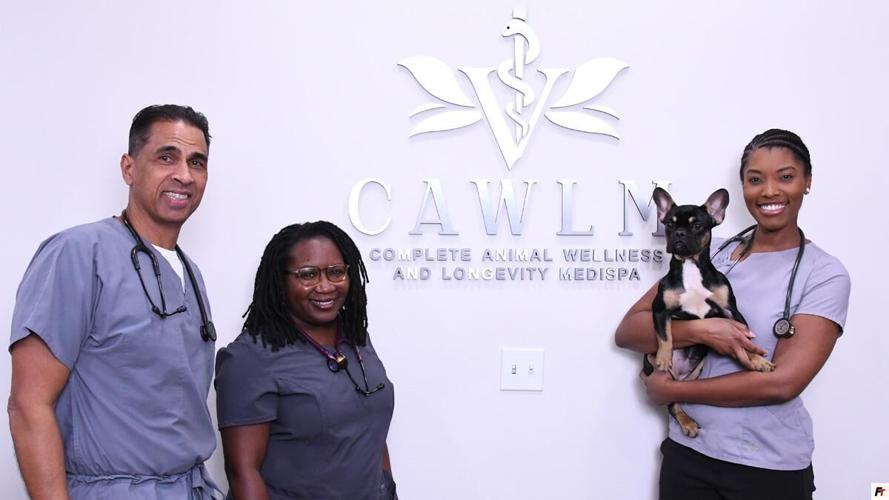
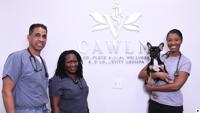

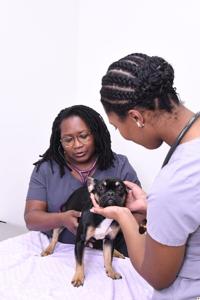

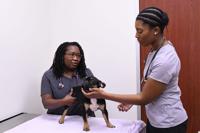

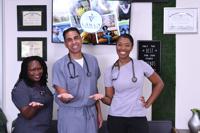


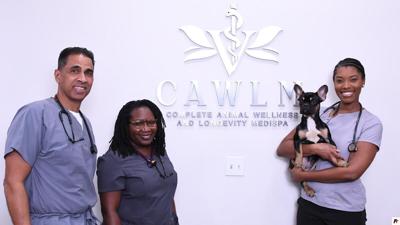






Commented
Sorry, there are no recent results for popular commented articles.